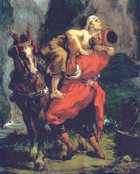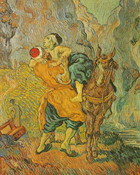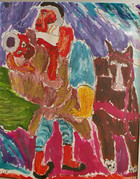Eugene Delacroix
The Good Samaritan (1849)
Oil on canvas
When I first saw Marian Kamp’s vibrantly colored drawing of The Good Samaritan at the Marvelous Miracles: Outsider Art and Bible Stories exhibition at Amsterdam’s Bijbelsmuseum in the fall of 2010, I immediately recognized a “family connection” to one of my favorite paintings by Modern Dutch Master Vincent van Gogh. On a trip to the Netherlands a few months earlier, I had trekked out to the Kroller-Muller Museum in the middle of the Hoge Veluwe National Park in Otterlo to spend some time with the same van Gogh painting of the New Testament parable, which had inspired Outsider Artist Kamp’s striking mixed media work.
The Marvelous Miracles show was a joint project of the Bijbelsmuseum and the Jan Pakhuys art studio for the mentally disabled in Amersfoort, the Netherlands, run by Amerpoort mental health services. Artists in the program were given the assignment of creating works, based on Bible stories and masterpieces of sacred art. Marian selected van Gogh's painting of the Good Samaritan story, displaying her passion for fabric design in a vivid, patchwork-quilt colored version of the more muted original. The Outsider Art was on sale to raise funds for Amerpoort, so, I was delighted to add the Kamp piece to the Sacred Art Pilgrim Collection in homage to a Van Gogh painting we both admired.
The “pedigree” for Marian’s wonderful little drawing can be traced one generation further back from the van Gogh original. His painting of the parable in Luke 10:30-37 is formally titled, The Good Samaritan (After Delacroix). Just as Kamp had copied the 1890 van Gogh painting, van Gogh had based his piece on a 1849 work in oil by French Romantic Artist Eugene Delacroix. The Failed-Preacher-turned Painter did only a handful of works on religious subjects, but the two most famous, a Pieta and this Good Samaritan, are based on Delacroix reproductions and were painted while he was in an asylum at Saint-Remy-de-Province.
During the year van Gogh spent in Saint-Remy from 1889-1890, he often found themes for his art in black and white prints of works by other artists, recreating them in his own style and color scheme. Van Gogh's painting of the New Testament parable is a mirror-image of the Delacroix original, as he would have seen it flipped around in a print reproduction. He uses a familiar palette of gold, ochre, blue and violet, vibrating with the colors of Southern France.
The day I was admiring the Van Gogh painting in the Kroller-Muller collection, a security guard (and amateur van Gogh historian) came up to offer his interpretation of the image. He thought it depicted Vincent's dependence on his younger brother Theo, whose bearded likeness can be seen in the Good Samaritan. The battered victim, being tenderly lifted onto the donkey, is van Gogh, himself, shown beardless, as he is in a self-portrait from the same period. The pilfered case by the road side represents the artist’s sense of aesthetic and material loss during his year of crisis at the asylum.
The next step in my genealogical search was tracking down the “grandfather” image for Marian’s work, the 1849 painting by Delacroix, which had inspired van Gogh. It is in a private collection, to be seen only in reproductions. With its bold splashes of red and green, the Delacroix original seems more akin to Kamp’s brightly colored mixed media piece than van Gogh’s copy. Brilliant reds feature prominently in the work of this Romantic Era painter, whose free brushwork and experiments in color and lighting foreshadowed the Impressionists’ break with traditional figurative art.
In the conventional aesthetic equation of modernism with secularism, Delacroix is usually portrayed as a radical sceptic who had little time for organized religion and a passing interest, at best, in the subjects he portrayed in church commissions. Art Historian Joyce C. Polistena makes a compelling case for a revisionist view of Delacroix as a serious painter of modern religious art, who devoted 120 paintings and over 220 drawings to traditional sacred themes.
Delacroix's figure grouping may have been influenced, in turn, by studies of the Good Samaritan, attributed to Italian Baroque Painter Domenico Fetti, which can be found in the collections of the Metropolitan Museum and the Boston Museum of Fine Arts. Viewing these uninspired pieces, which look more like landscapes than works of sacred narrative, I feel confident in giving Delacroix full credit for an image prototype, inspiring two other "generations" of artists.
In a work of true genius, the French artist turns the Samaritan’s act of charity into dramatic depiction of muscular Christianity, where we feel the very weight of this good work in the contorted torsos, bent backs, twisted toes, and claw-like, clutching hands of the two figures. Delacroix beautifully conveys the passion of compassion.



